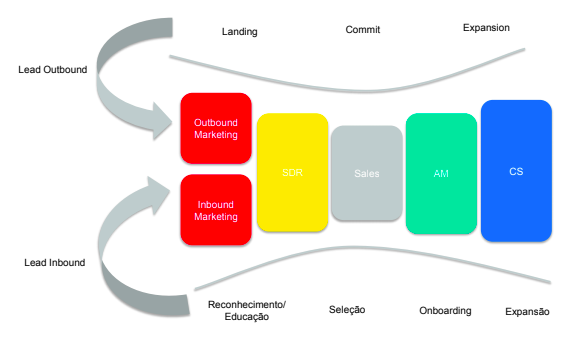Structuring a commercial department is much more than hiring sales specialists and assigning certain titles. In reality, a successful sales department is made up of technologies that accelerate performance, sales support resources, and an agile sales force with certain skills – all under a customer-centric sales process.
And it’s not just us who say it. Renowned consultant and author Jacco van der Kooij, a SaaS sales specialist based in Silicon Valley, argues that these are the 5 best sales practices he has had the opportunity to see in action in successful Startups.
-
Customer-Centric Sales Process
First of all, what is a sales process? A sales process is a guide for how sales should unfold, which standardizes and systematizes everything in order to create a quality, consistent and complete consumer experience. From the point of view of the sales manager, it is also useful because it allows evaluation of professionals, activities, and incisively acting on problems.
In the sales process, everything is planned: contact cadences, how to discover pain points and objections, lead qualification, how to do a product demonstration, call scripts, all the steps to close the deal, etc.
Companies without these internal processes end up in very precarious situations: they have difficulties in training new recruits, they do not learn from their mistakes, and they are dependent on the experience of a few isolated salespeople (who may leave, taking their good practices and contacts with them).
Now that we’ve explained what a sales process is, let’s see why you should create it with the customer in mind.
Focusing the sales process on the customer means adapting to their needs at each sales funnel stage. Over time, build a dialogue in which the customer feels heard and acts as an ally in resolving a problem.
Taking the different stages into account helps to avoid a mismatch between where the salesperson thinks they are and where the customer actually is in their buying journey.
This is a real risk. Sellers are results-oriented, so it’s very tempting to push a potential customer step by step, as quickly as possible, toward the purchase decision.
Imagine, for example, that the salesperson is preparing the proposal while the customer is still just acknowledging the problem he has. As the seller fails to correctly assess the information needs of this contract, the negotiation is doomed to fail.
To differentiate yourself from the competition, it is essential to adopt an advisory role and work with the pains, challenges, and specific goals of each prospect. Thus, you are helping a potential client to make the best decision and to cultivate a lasting relationship of trust.
In 2007, it took an average of 3.68 call attempts to reach prospects. 13 years later, it takes 18 attempts. Only 23.9% of sales emails are opened.
The decline in effectiveness, and even with the emergence of social selling and referrals, the cell phone and emails continue to be important tools for direct contact. How to make them more effective? The answer is in the content: insights, tools, news, statistics or studies, anything that enriches the prospect’s life.
Sharing a useful resource – and not more of the same, which is the product and the company – is increasingly asserting itself as the best way to start a conversation, gain the prospect’s attention and advance the negotiation.
This forces you to hire sales specialists who manage to escape the traditional sales script (“I’m here to tell you about the upgrade we made to the XPTO product, etc”) and who are able to gather relevant insights (“the latest statistics in your sector show that X% of companies use a technological solution like ours” or “Have you seen the latest free tool we created to increase your productivity?”).
In this way, they manage to position themselves as trusted advisors, reduce the perception of risk in the purchase and accelerate sales.
-
Sales-accelerating technologies Sales
technologies are also known as enablement. No matter how well your salespeople are trained, you can’t expect exponential growth if you don’t use technologies that multiply efforts. Even because, probably, your competitors are already using them to make more and better contacts.
These technologies can be part of the sales stack from any B2B company, regardless of industry:
- Marketing automation software – automate contact management, segmentation and content nurturing.
- CRM – prospect management, sales pipeline management and monitoring of key metrics.
-
- Inside Sales Software – software to plan and make customer calls and remote product demonstrations with integration with CRMs; monitor the metrics and recordings of each sales rep, which allows for coaching.
- Dashboard Software, Proposal Software, Email Marketing, LinkedIn Sales Navigator, etc.
-
Coaching for the Right Skills
Traditional sales coaching is light years away from today’s sales reality. It does not focus on developing the necessary skills to sell online, it is not focused on the customer, and it does not include tools to accelerate sales.
Modern sales force coaching must be done according to the specialization of each rep (Sales Developer, Account Executive, Customer Success Manager, Account Manager, etc.), always emphasizing problem-solving.
One of the realities of today’s commercial departments is a high turnover of just a few months. Therefore, it is important for sales managers to implement a process that can serve as a basis for quickly training new talent, as well as providing individual coaching. Together, these two strategies promote agile sales teams, capable of maintaining performance even in the face of turnover.
It may seem counterintuitive, but hiring top-notch salespeople with immense experience is not always a good bet for this sales force. The more experienced ones are not as permeable to coaching, and in these cases, the success of the sales operation depends on a consistent consumer experience in all stages, from Marketing to Sales and Customer Success.












